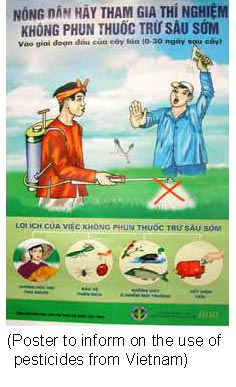Creating extension materials
 What are extension materials?
What are extension materials?
Extension materials aim at communicating a simple message to motivate the target group (for example, rice farmers) to change the way they do something. Extension materials can be verbal communications, bulletins/brochures, posters, radio dramas or videos.
Why develop extension materials?
Farmers adopt an alternative technology when they 1) are aware of it, 2) understand it and 3) are motivated to try the alternative and try it correctly. Extension materials therefore need to raise awareness and communicate: 1) the benefits of the technology and 2) how to correctly apply the technology.
How to develop extension material?
Extension materials need to motivate people to change what they do. When considering change, farmers will usually try a technology in just part of their field. Once they are convinced of the benefits, they will typically adopt the technology more widely.
Six steps to developing extension material
After you have identified a problem and decided on and/or developed an appropriate technology you:
- Decide on the medium of communication (written, radio, video etc).
- Develop the material with a range of interested groups (farmers, other extension workers, scientists etc).
- Briefly describe the problem and the type of farmer that the technology is suitable for (e.g., what sort of crops, environments, farming practices).
- Describe/Analyze the technology in simple terms:
- What is it?
- What are the essential parts of the message (the minimum knowledge needed to correctly apply the technology)?
- What are the benefits (e.g., greater returns, less labor, better safety, lower risk)?
- What are the risks? Why would some not adopt the technology?
- Develop the material; (written) materials need to be:
- Focused and concise (avoid saying too much)
- Appropriate for the culture and literacy of the target group
- Easy to read
- Illustrated with images easily understood by the target audience
- Logically ordered
- Active — write to encourage action and clearly state where farmers can get more information.
- Pre-test materials with the target group and respond to their feedback.
- Pre-testing allows you to check and/or improve ideas, communication content and other extension materials by submitting them to a small group that represents the target population.
Example of a technology analysis








